 France (1890) – Armoured Cruiser
France (1890) – Armoured CruiserWW1 French Cruisers
Sfax | Tage | Amiral Cecille | D'Iberville class | Dunois class | Foudre | Davout | Suchet | Forbin class | Troude class | Alger class | Friant class | Linois class | Descartes class | D'Assas class | D’Entrecasteaux | Protet class | Guichen | Chateaurenault | Chateaurenault | D'Estrées class | Jurien de la Graviere | Lamotte-Picquet classDupuy de Lome | Amiral Charner class | Pothuau | Jeanne d'Arc | Gueydon class | Dupleix class | Gloire class | Gambetta class | Jules Michelet | Ernest Renan | Edgar Quinet class
The cruiser Dupuy de Lôme was not only the first French armoured cruiser, but also one of the most revolutionary of her time. She was named after French engineer Dupuy de Lôme, a visionary that -among others- created the first steam battleship, seagoing ironclad, and submarine. The cruiser was also the product of the French Jeune Ecole naval think tank (“young school”) that professed the use of armoured cruisers and torpedo boats instead of battleships.
About the namesake, Henri Dupuy de Lôme
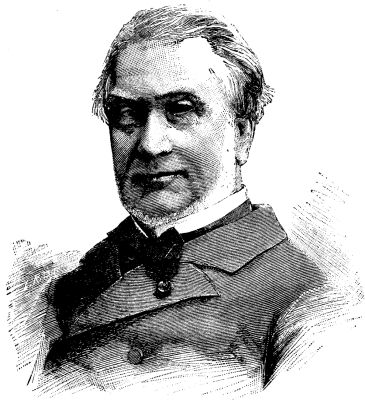 Breton Henri Dupuy de Lôme (born 1885) was probably the most influential naval engineer of his era. He was a French naval architect, son of a naval officer, and from a region that always prided itself to have been the cradle of French sailors. De Lôme went to England in 1842, making a thorough study of iron shipbuilding and steam navigation and writing a report. He started work at the arsenal in Toulon at a time the only French Naval steamships were paddle ships used for liaison and as “estafettes” (dispatch vessels).
Breton Henri Dupuy de Lôme (born 1885) was probably the most influential naval engineer of his era. He was a French naval architect, son of a naval officer, and from a region that always prided itself to have been the cradle of French sailors. De Lôme went to England in 1842, making a thorough study of iron shipbuilding and steam navigation and writing a report. He started work at the arsenal in Toulon at a time the only French Naval steamships were paddle ships used for liaison and as “estafettes” (dispatch vessels).
It was totally unsuitable to larger ships, and the line of battle was still populated by tall ships, three and four deckers and frigates, like a century before. However there was still little confidence in the screw, just developed (British SS Archimede, 1838). But he also later carefully studied the SS Great Britain (1843) in construction, that married comfortable dimensions, an iron hull and large steam engines with one screw. This convinced him that a large steam-powered warship was feasible, using the same principles. He adressed a report in 1845 to the minister of Marine about a Frigate, screw-driven and with an iron hull and a belt of thick armour.
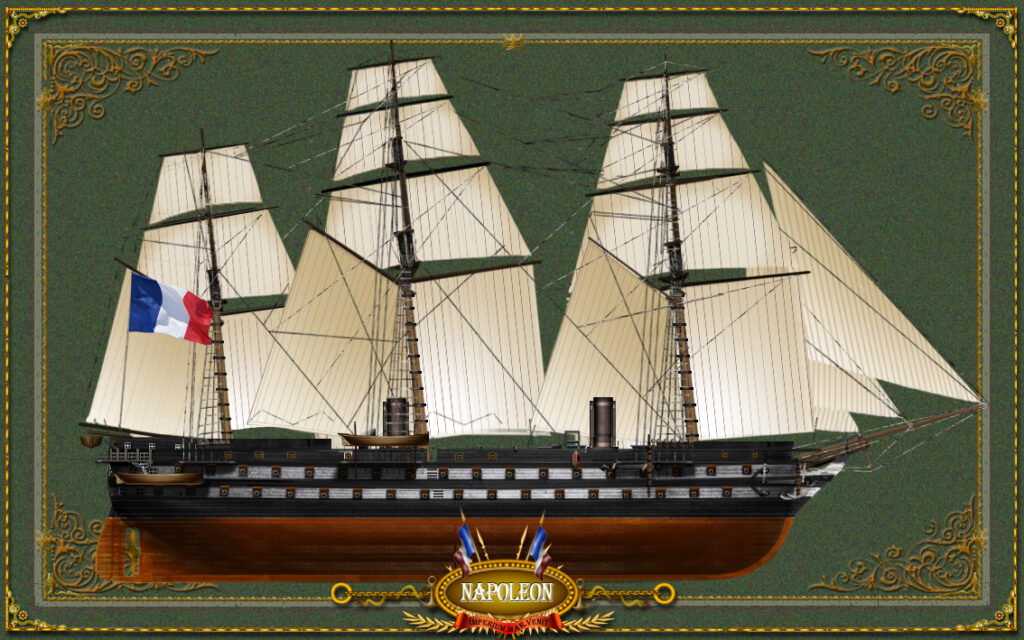
His colleagues of the Génie Maritime (naval engineering) pushed this idea and this was rewarded eventually in 1847, as the Napoléon was ordered. Launched in 1850, the first screw ship-of-the-line ever built was proven in the following Crimean war. The concept immediately triggered a flurry of conversions or fresh construction of steam ships-of-the-line in France and UK, including the largest steamship of the line of that time, HMS Duke of Wellington.
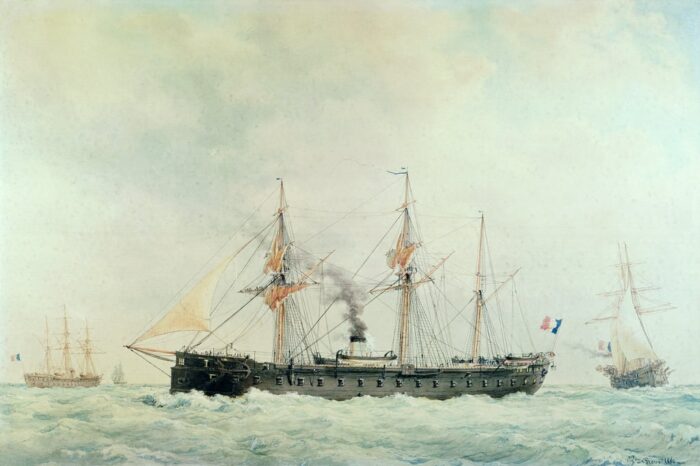
Later on, he built La Gloire, essentially the result of his earlier report, with growing industrial capabilities and Dupuy de Lôme has been appointed Directeur du Matériel and pretty much had his hands free on this project. Contruction of the Gloire was already known in the Royal Navy, that started to work in a much larger ship which became the HMS Warrior, first iron-hull steam-driven sea going ironclad. He will also later created the Solférino, (Magenta class) the only two-decked broadside ironclad battleships ever built.
If this was not enough, De Lôme also embarked in the construction of Navigable balloons which could be used by the Navy for long range reconnaissance. Before he passed out, he also worked on an pioneering electric submarine, Le Plongeur, in 1863 which used a compressed-air engine, powering a reciprocating engine and armed with a spar explosive.

Le Plongeur
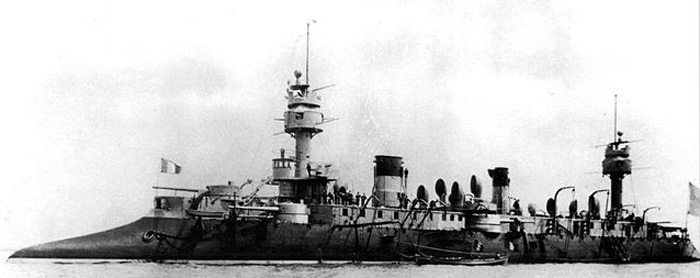
Dupuy-de-lôme
For some, the first armoured cruiser
This cruiser had been dubbed by some authors as the world’s first armoured cruiser, a Young School concept essentialy intended to attack enemy merchant ships, those of the British Empire. In this commerce-raiding strategy she was supposed to deal with protected cruisers that made the possible escort of these ships, or were to be encountered, while being fast enough to distance battleships. By her strong protection she was indeed quite superior to the “protected” type. She was also agile in the way she fired, using heavy armament of quick-firing guns all mounted in gun turrets. That was in stark contrast to the pivot guns and barbettes of her opponents at the time.
A 6500 tonnes cruiser with a pronounced tumblehome (the slope was supposed to deal with horizontal fire, by presneted artificially increased thickness) and a very long sprur, ram bow, unarmoured. The hull section was well-rounded, which gave the ship a long, slow roll and unstable gunnery platform. Dupuy de Lôme was also given two large military masts housing light QF guns to deal with torpedo boats.
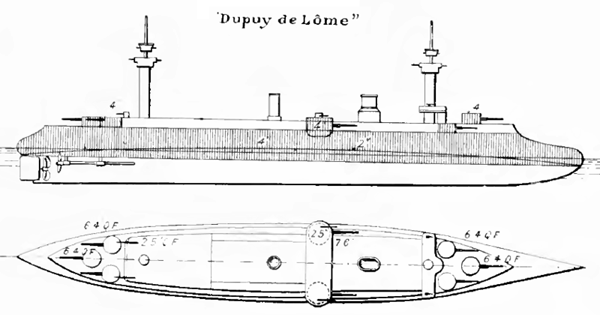
She was propelled by triple-expansion steam engines of the vertical type (centre shaft) and horizontal type (outboard shafts). They drove 4.2 to 4.4 metres (13 ft 9 in) diameter propellers. Steam came from 11 Amirauté fire-tube boilers, rated for 14,000 metric horsepower (10,000 kW). Design top speed was 20 knots (37 km/h; 23 mph).
But on sea trials in April 1895 only 13,186 metric horsepower (9,698 kW) were obtained, so maximum speed was 19.73 knots (36.54 km/h; 22.70 mph). 1,080 tonnes (1,060 long tons; 1,190 short tons) of coal were carried, which gave a 4,000 nautical miles (7,400 km; 4,600 mi) at 12.5 knots.
Dupuy de Lôme was armed with two types of main artillery and three types of secondary guns plus torpedo tubes: Two Canon de 194 mm Modèle 1887/40 guns. But they were nbot found for and aft but on broadsides amidship. Instead, six Canon de 164 mm Modèle 1887/45 guns, each in single gun turrets were found at the bow and stern.
Complementary, for close defence, they received ten 47-millimetre (1.9 in) and four 37-millimetre (1.5 in) Hotchkiss guns distributed in the superstructures and military masts. The four 450-millimetre (17.7 in) pivoting torpedo tubes were mounted on each broadside above water, bow and stern.
But the most important part in the design was the 100 millimetres (3.9 in) of steel armour protecting the sides, starting 1.38 metres (4 ft 6 in) below the waterline, up to the weather deck. The curved protective deck was 30 millimetres (1.2 in) while the boiler and engine rooms, and the magazines had a splinter deck 8 millimetres (0.31 in) thick, with spaces that could be filled with coal. There was also a watertight internal cofferdam filled with cellulose from behind the waterline, to one meter above it.
The hull was also divided into 13 watertight transverse bulkheads, and more above the protective deck. On the superstructures, the conning tower was 125 mm (4.9 in) thick and the turrets 100 mm.
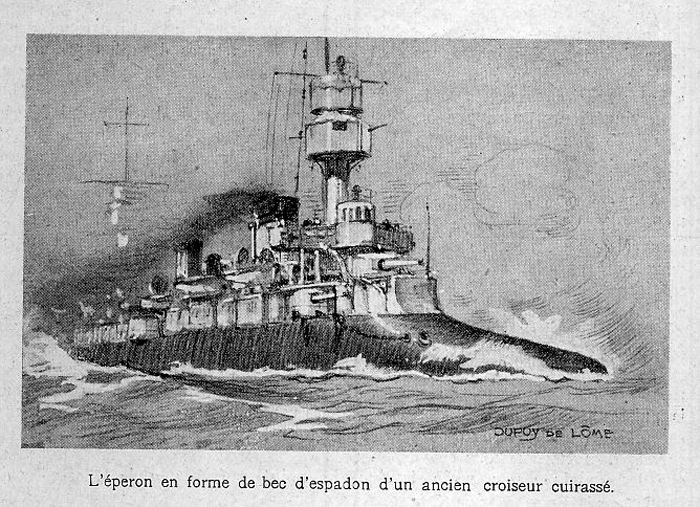
The Dupuy de Lôme in service

Completion the ship was delayed by almost two years because of boilers issues, first a boiler exploded, then several boilers were found structurally unsound and the yard obtained to have them all replaced by the manufacturer. Also, many of the armour plates were not properly hardened and proved defective.
She was commissioned eventually in 1895, assigned to the Northern Squadron (Escadre du Nord) in Brest.
Her first official visite was to represent France at the opening of the Kiel canal. She visited several foreign ports, escorted the Russian Imperial yacht, and carried the President of France, Félix Faure, to Russia in 1897, but her roll was noted as too strong. She received Bilge keels during a short refit. She represented France also at Spithead during Queen Victoria’s funeral in 1901.
In 1902 she was taken in hands in drydock for a lengthy reconstruction. The cruiser has new machines installed in 1905, 20 new Guyot–du-Temple water-tube boilers, served by three funnels. This propelled her to 18.27 knots (33.84 km/h; 21.02 mph) from 12,887 metric horsepower (9,478 kW).
The two military masts were replaced by simple masts and armament was modified. This overhaul dragged on until 1906, and at that time the Young School theories has been out of favor and the cruiser was regarded as obsolete.
In addition, the ship’s plates were rusting while the entire water distribution system had to be changed. This was judged uneconomical and she was placed into reserve.

The Dupuy de Lôme was re-commissioned only for a short time to serve in Morocco.
Eventually the Peruvian Government approached France and negociations started. The cruiser should have been sold to Peru in 1912 for the price of three million francs. Indeed this has been trigerred by a rumor that the Italian cruiser Umbria was to be sold to Ecuador.
But she was finally never paid for entirely. What happened was the French repaired the ship (that the Peruvians promised to refund) and after the first installment of the signed price, she was officially renamed Commandante Aguirre and transferred to the Peruvian Navy.
However the rumors proved to be false as the Ecuadorians never obtained the Umbria, which was sold to Haiti instead. The Peruvian government lost interest in the purchase and never paid the remainder. The cruiser was therefore taken back by the French Navy in 1917 as they needed ships for the Mediterranean.
She had been left in reserve until 1914, almost without maintenance, and was not really engaged in operations but served as a harbor guard ship.
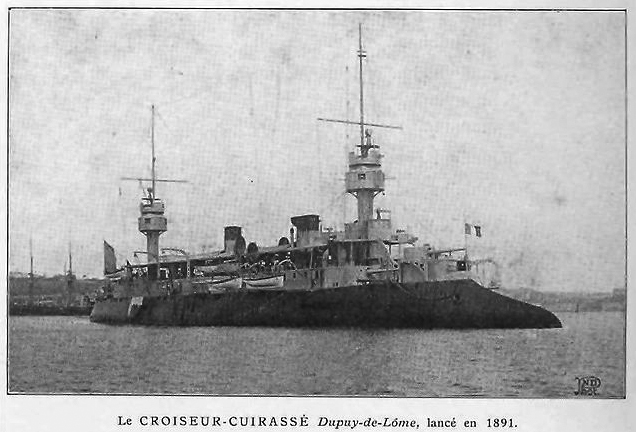
The cruiser was to be resold after the war to a Belgian trade company called Lloyd Royal Belge (LRB) to serve as cargo under the name of Peruvier, after a new radical overhaul. She was indeed converted into a freighter by Chantiers de la Gironde near Bordeaux, France, after the armament was deposed, the yard removed all the armour without compromising the structural integrity.
During her maiden voyage in 1920 en route to Rio de Janeiro from Cardiff she carried 5,000 tonnes (4,900 long tons) of coal but the ship’s engines broke down mid-way (they already has been repaired at Falmouth before the trip).
She had to be towed to Las Palmas, then Pernambuco. There, it was discovered that part of her coal cargo has been burning for days. Thus deformed the hold and hull. She was deemed uneconomical to repair and the company decided to resold her to a Flushing (Antwerp) broker and she was scrapped in 1923.
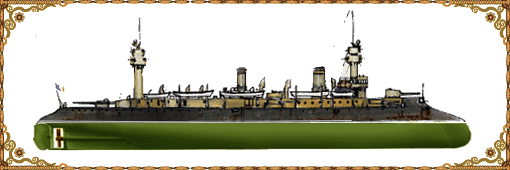
Actual livery of the cruiser before refit. Black hull, copper acetoarceniat green under the waterline, canvas beige for the superstructure. It was painted standard overall grey afterwards and the hull was probably repainted in modern red.
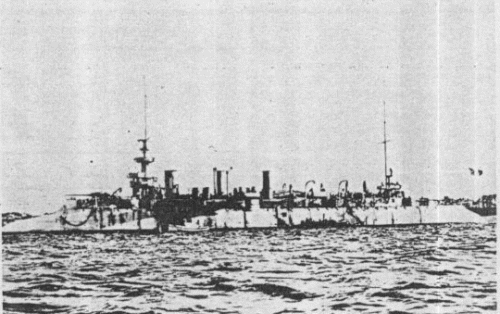
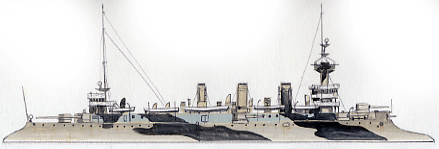
An hypothetic livery inspired by a low-quality, grainy photo of the ship (above). It could well be the shadow of some elements, there is no other photo actually showing the ship wih any camouflage at all. French ships during ww1 were rarely camouflaged.
Both are author’s illustrations
Dupy de Lôme specifications |
|
| Dimensions | 114 x 15.7 x 7.07 m (374 x 51 x 23 ft) |
| Displacement | 6,301 tonnes (6,201 long tons) |
| Crew | 521 |
| Propulsion | 3 screws, TE engines, 11 Amirauté boilers, 13,000 ihp |
| Speed | 20 knots (37 km/h; 23 mph), Range 4,000 nmi (7,400 km; 4,600 mi) |
| Armament | 2 x 194, 6 x 164, 4 x 65, 10 x 47 mm, 4 x 37, 4 TT SM 457 mm |
| Armor | 30 mm Deck, Belt 100 mm, CT 125 mm, Turrets 100 mm. |
Read More
Conway’s all the world’s fighting ships 1860-1906
on wikipedia.org
On navypedia.org/
HD photo on dennilfloss.blogspot.com
combrig-models.com – 3d views


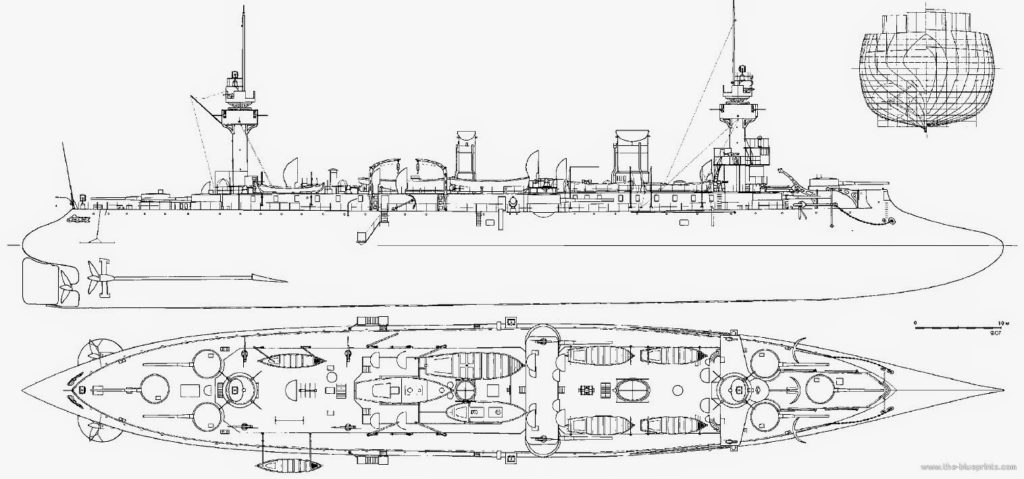
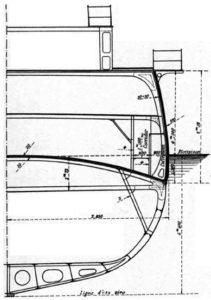
 Latest Facebook Entry -
Latest Facebook Entry -  X(Tweeter) Naval Encyclopedia's deck archive
X(Tweeter) Naval Encyclopedia's deck archive Instagram (@navalencyc)
Instagram (@navalencyc)





 French Navy
French Navy Royal Navy
Royal Navy Russian Navy
Russian Navy Armada Espanola
Armada Espanola Austrian Navy
Austrian Navy K.u.K. Kriegsmarine
K.u.K. Kriegsmarine Dansk Marine
Dansk Marine Nautiko Hellenon
Nautiko Hellenon Koninklije Marine 1870
Koninklije Marine 1870 Marinha do Brasil
Marinha do Brasil Osmanlı Donanması
Osmanlı Donanması Marina Do Peru
Marina Do Peru Marinha do Portugal
Marinha do Portugal Regia Marina 1870
Regia Marina 1870 Nihhon Kaigun 1870
Nihhon Kaigun 1870 Preußische Marine 1870
Preußische Marine 1870 Russkiy Flot 1870
Russkiy Flot 1870 Svenska marinen
Svenska marinen Søværnet
Søværnet Union Navy
Union Navy Confederate Navy
Confederate Navy Armada de Argentina
Armada de Argentina Imperial Chinese Navy
Imperial Chinese Navy Marinha do Portugal
Marinha do Portugal Mexico
Mexico Kaiserliche Marine
Kaiserliche Marine 1898 US Navy
1898 US Navy Sovietskiy Flot
Sovietskiy Flot Royal Canadian Navy
Royal Canadian Navy Royal Australian Navy
Royal Australian Navy RNZN Fleet
RNZN Fleet Chinese Navy 1937
Chinese Navy 1937 Kriegsmarine
Kriegsmarine Chilean Navy
Chilean Navy Danish Navy
Danish Navy Finnish Navy
Finnish Navy Hellenic Navy
Hellenic Navy Polish Navy
Polish Navy Romanian Navy
Romanian Navy Turkish Navy
Turkish Navy Royal Yugoslav Navy
Royal Yugoslav Navy Royal Thai Navy
Royal Thai Navy Minor Navies
Minor Navies Albania
Albania Austria
Austria Belgium
Belgium Columbia
Columbia Costa Rica
Costa Rica Cuba
Cuba Czechoslovakia
Czechoslovakia Dominican Republic
Dominican Republic Haiti
Haiti Hungary
Hungary Honduras
Honduras Estonia
Estonia Iceland
Iceland Eire
Eire Equador
Equador Iran
Iran Iraq
Iraq Latvia
Latvia Liberia
Liberia Lithuania
Lithuania Mandchukuo
Mandchukuo Morocco
Morocco Nicaragua
Nicaragua Persia
Persia San Salvador
San Salvador Sarawak
Sarawak Uruguay
Uruguay Venezuela
Venezuela Zanzibar
Zanzibar Warsaw Pact Navies
Warsaw Pact Navies Bulgaria
Bulgaria Hungary
Hungary

 Bundesmarine
Bundesmarine Dutch Navy
Dutch Navy Hellenic Navy
Hellenic Navy Marina Militare
Marina Militare Yugoslav Navy
Yugoslav Navy Chinese Navy
Chinese Navy Indian Navy
Indian Navy Indonesian Navy
Indonesian Navy JMSDF
JMSDF North Korean Navy
North Korean Navy Pakistani Navy
Pakistani Navy Philippines Navy
Philippines Navy ROKN
ROKN Rep. of Singapore Navy
Rep. of Singapore Navy Taiwanese Navy
Taiwanese Navy IDF Navy
IDF Navy Saudi Navy
Saudi Navy Royal New Zealand Navy
Royal New Zealand Navy Egyptian Navy
Egyptian Navy South African Navy
South African Navy






























 Ukrainian Navy
Ukrainian Navy dbodesign
dbodesign